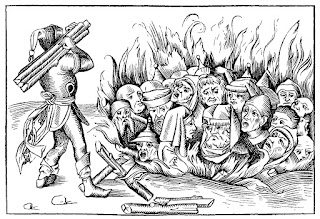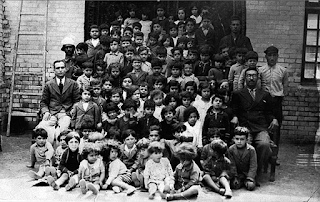Burning Jewish Cadavers in Antioch, 486
Antioch, Syria
486 CE
The Jewish community in Antioch dated back to at least the time of the Hasmoneans. Jews felt very secure in the community, even after Christianity because the religion of the Roman Empire.
In 486, the streets of Antioch were rocked by pitched battles between two political factions/supporters of rival sports clubs, the Greens and the Blues. While these groups were partially socioeconomic, they also were divided on the issue of whether Jesus was both divine and human, or only one (Monophysitism). The Jews sides with the Blues and, in revenge, the Greens set fire to a number of synagogues and murdered Jews. (Avner Falk, A Psychoanalytic History of the Jews, 351)
This story presents a strange twist on the normal killing-Jews-in-a-synagogue story. During one of these attacks on the Jews of Antioch, the Greens exhumed Jewish bodies from a nearby cemetery and tossed them into burning synagogues.
For good measures, in 507 the Greens again attacked synagogues, this time in nearby Daphne.
Scholars have discussed a number of possibilities as to why these two groups, basically fans of different chariot racing teams, would let their dispute roll over into attacks on the Jews. One scholar writes that the Jews sat among the Blues at the hippodrome, and thus became part of their faction. Others simply felt this was a convenient reason to attack Jews. (Pieter Willem van der Horst, Jews and Christians in Their Graeco-Roman Context, 54-57)
486 CE
The Jewish community in Antioch dated back to at least the time of the Hasmoneans. Jews felt very secure in the community, even after Christianity because the religion of the Roman Empire.
In 486, the streets of Antioch were rocked by pitched battles between two political factions/supporters of rival sports clubs, the Greens and the Blues. While these groups were partially socioeconomic, they also were divided on the issue of whether Jesus was both divine and human, or only one (Monophysitism). The Jews sides with the Blues and, in revenge, the Greens set fire to a number of synagogues and murdered Jews. (Avner Falk, A Psychoanalytic History of the Jews, 351)
This story presents a strange twist on the normal killing-Jews-in-a-synagogue story. During one of these attacks on the Jews of Antioch, the Greens exhumed Jewish bodies from a nearby cemetery and tossed them into burning synagogues.
"The Greens attacked the synagogue and burned it, and dug up and burned on a pyre the bodies of the Jews who were buried there...Malalas reports that when [Eastern Roman Emperor] Zeno, who was favorable to the Greens, was told of this incident, he was angry with the Greens because they had burned only dead Jews and had not thrown living ones on the fire." (Glanville Downey, History of Antioch, 497-8, quoting John Malalas, Chronopraphia, 15.15)Apparently burning Jews in synagogues was already enough of a thing, that the Emperor was sad to have missed out on this opportunity.
For good measures, in 507 the Greens again attacked synagogues, this time in nearby Daphne.
Scholars have discussed a number of possibilities as to why these two groups, basically fans of different chariot racing teams, would let their dispute roll over into attacks on the Jews. One scholar writes that the Jews sat among the Blues at the hippodrome, and thus became part of their faction. Others simply felt this was a convenient reason to attack Jews. (Pieter Willem van der Horst, Jews and Christians in Their Graeco-Roman Context, 54-57)




Comments
Post a Comment